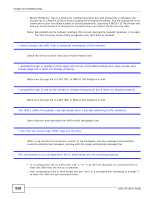ZyXEL UAG715 User Guide - Page 514
Interface Type, General, Interface, Internal, External
 |
View all ZyXEL UAG715 manuals
Add to My Manuals
Save this manual to your list of manuals |
Page 514 highlights
Chapter 46 Troubleshooting The UAG routes and applies SNAT for traffic from some interfaces but not from others. The UAG automatically uses SNAT for traffic it routes from internal interfaces to external interfaces. For example LAN to WAN traffic. You must manually configure a policy route to add routing and SNAT settings for an interface with the Interface Type set to General. You can also configure a policy route to override the default routing and SNAT behavior for an interface with the Interface Type set to Internal or External. The UAG is not applying a policy route's port triggering settings. You also need to create a firewall rule to allow an incoming service. I cannot get Dynamic DNS to work. • You must have a public WAN IP address to use Dynamic DNS. • Make sure you recorded your DDNS account's user name, password, and domain name and have entered them properly in the UAG. • You may need to configure the DDNS entry's IP Address setting to Auto if the interface has a dynamic IP address or there are one or more NAT routers between the UAG and the DDNS server. • The UAG may not determine the proper IP address if there is an HTTP proxy server between the UAG and the DDNS server. I cannot create a second HTTP redirect rule for an incoming interface. You can configure up to one HTTP redirect rule for each (incoming) interface. The UAG keeps resetting the connection. If an alternate gateway on the LAN has an IP address in the same subnet as the UAG's LAN IP address, return traffic may not go through the UAG. This is called an asymmetrical or "triangle" route. This causes the UAG to reset the connection, as the connection has not been acknowledged. You can set the UAG's firewall to permit the use of asymmetrical route topology on the network (so it does not reset the connection) although this is not recommended since allowing asymmetrical routes may let traffic from the WAN go directly to the LAN without passing through the UAG. A better solution is to use virtual interfaces to put the UAG and the backup gateway on separate subnets. See Asymmetrical Routes on page 242 and the chapter about interfaces for more information. 514 UAG715 User's Guide















